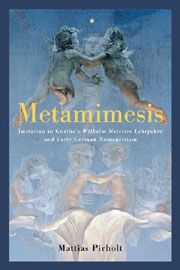Book contents
- Frontmatter
- Contents
- Acknowledgments
- List of Abbreviations
- Introduction
- 1 Romanticism, Mimesis, and the Novel
- 2 Double-Entry Imagery: Johann Wolfgang Goethe's Wilhelm Meisters Lehrjahre
- 3 Imitation and Indolence: Friedrich Schlegel's Lucinde
- 4 Imitation and Simulation: Novalis's Heinrich von Ofterdingen
- 5 Beyond Romantic Representation: Clemens Brentano's Godwi
- Conclusions: Mimesis and the Critical Politics of Romanticism
- Bibliography
- Index
1 - Romanticism, Mimesis, and the Novel
Published online by Cambridge University Press: 05 February 2013
- Frontmatter
- Contents
- Acknowledgments
- List of Abbreviations
- Introduction
- 1 Romanticism, Mimesis, and the Novel
- 2 Double-Entry Imagery: Johann Wolfgang Goethe's Wilhelm Meisters Lehrjahre
- 3 Imitation and Indolence: Friedrich Schlegel's Lucinde
- 4 Imitation and Simulation: Novalis's Heinrich von Ofterdingen
- 5 Beyond Romantic Representation: Clemens Brentano's Godwi
- Conclusions: Mimesis and the Critical Politics of Romanticism
- Bibliography
- Index
Summary
Der Gegenstand der Kunst, wie wir gesehen haben, ist nothwendig Natur. Die Idee der Natur haben wir in uns, aber historisch genommen, wie wir sie in der Erfahrung kennen lernen, bleibt sie für uns unübersehbar und unergründlich. (V I, 261)
The immense amount of scholarship attempting to define the nature or essence of romanticism has suggested that one's interpretation of mimesis constitutes a dividing line between, on the one hand, (neo)classicism and the Enlightenment and, on the other, romanticism. After the resurrection of the interest in the romantic movement in the early twentieth century, brought about first by Ricarda Huch and Josef Nadler and then by H. A. Korff, Josef Körner, Julius Petersen, and Fritz Strich, the consensus has been that the young romantics put a definite end to the hegemony of classicism by replacing mimesis, or the imitation of nature, with new aesthetic ideals. Instead of being subjected to the rules and techniques of reproducing nature through verisimilitude, the artist was now a free, productive creator, equivalent or at least comparable to God or nature itself — as in Lord Shaftesbury's attractive idea of the artist as a second maker. What led to the romantic revolution is often seen as a process that went on for several decades, beginning in the early eighteenth century, but the work of the Jena romantics was crucial. Its consistent and deliberate renunciation (Abkehr) of the aesthetics of imitation is construed as a key factor in the romantic revolution.
- Type
- Chapter
- Information
- MetamimesisImitation in Goethe's 'Wilhelm Meisters Lehrjahre' and Early German Romanticism, pp. 10 - 40Publisher: Boydell & BrewerPrint publication year: 2012

